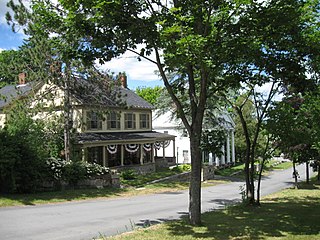
The John C. Pollock House is a historic residence in the city of Wyoming, Ohio, United States. Erected in the 1870s, it was originally the home of a prosperous businessman, and it has been designated a historic site because of its architecture.

Prospect Harbor Point Light is a lighthouse on Prospect Harbor Point, which divides Sand Cove from Inner Harbor at the head of Prospect Harbor on the southern shore of Gouldsboro, Maine. Also known as Prospect Harbor Light, it was first established in 1850. The present structure was built in 1891. It was listed on the National Register of Historic Places as Prospect Harbor Light Station in 1988.

Highland Cottage, also known as Squire House, is located on South Highland Avenue in Ossining, New York, United States. It was the first concrete house in Westchester County, built in the 1870s in the Gothic Revival architectural style. In 1982 it was listed on the National Register of Historic Places; almost 30 years later, it was added to the nearby Downtown Ossining Historic District as a contributing property.

Whitneyville Congregational Church is a historic church on Main Street in Whitneyville, Maine. Built 1869-76, it is an unusually high-style Italianate building for a remote rural setting. It was listed on the National Register of Historic Places in 1979.

The Gilmore House is a historic house at 764 River Road in Calais, Maine. The 2+1⁄2-story wood-frame house was designed by New Brunswick architect Matthew Stead and built c. 1850, probably for Alexander Gilmore, an Irish immigrant and local merchant. The house is a remarkably sophisticated execution of Gothic Revival styling, given that at the time of its construction, Calais was essentially a frontier town. It is the most sophisticated of a trio of Gothic Revival houses. It is, like one of its neighbors, the George Washburn House, listed on the National Register of Historic Places, although its address has changed since its listing.

The Seavey-Robinson House is a historic house built in the Carpenter Gothic style in South Portland, Maine. Built c. 1854–57, it is a rare example of a Carpenter Gothic cottage, originally built in a rural setting, since urbanized. It was added to the National Register of Historic Places in 1986.

The Samuel D. Philbrook House is a historic house at 162 Main Street in Bethel, Maine. Built in 1878-79 by a local businessman, it is probably the most elaborate Italianate residence in the community, and one of the finest of the type in Oxford County. It now houses a retail space in the first floor and attached barn, with living space above. It was listed on the National Register of Historic Places in 1995.

The Calais Residential Historic District encompasses the town's best collection of well-preserved 19th-century residences in Calais, Maine. Located on Calais Avenue and Main Street, the district includes twenty properties developed between the early 19th century and 1900. It was listed on the National Register of Historic Places in 1994.

The Thomas Hamilton House is a historic house at 78 South Street in Calais, Maine. Built about 1857, it is a high-style Italianate house, unusual in its sophistication for what was then a remote frontier setting. Thomas Hamilton, the builder, had pretense at grandeur, and his house became a local landmark known as "Hamilton's Folly". The house was listed on the National Register of Historic Places in 1982.

The Holmes Cottage is a historic house at 521 Main Street in Calais, Maine. Estimated to have been built about 1820, it is the oldest surviving structure in the town, and is notable for its association with Dr. Job Holmes, a leading physician during the community's formative years. The cottage, now owned by the St. Croix Historical Society and operated by them as the Dr. Job Holmes Cottage & Museum, was listed on the National Register of Historic Places in 1988.

The Theodore Jellison House, also known locally as the Stone House, is a historic house on River Road in eastern Calais, Maine. Built in 1825, it is one of the oldest surviving residences in the town, and an impressive local example of granite construction. Theodore Jellison, its builder, was a local owner of granite quarries. The house was listed on the National Register of Historic Places in 1984.

The McGlashan-Nickerson House is a historic house on St. Croix Drive in the village of Red Beach, part of Calais, Maine. Built about 1883, it is a fine example of Italianate architecture, built for one of the principals of the Maine Red Granite Quarry Company. It was listed on the National Register of Historic Places in 1990. It is now owned by the National Park Service, housing facilities that support operation of the adjacent St. Croix Island International Historic Site.

The Capt. John P. Nichols House is a historic house at 121 East Main Street in Searsport, Maine. Built in 1865 for a ship's captain from a prominent local family, it is one of Waldo County's finest examples of Italianate architecture, with a particularly elaborate cupola. The house was listed on the National Register of Historic Places in 1983. It is now the Homeport Inn.

The Clark Perry House is a historic house on Court Street in Machias, Maine. Built in 1868, it is one of Washington County's most elaborate examples of Italianate architecture. It was listed on the National Register of Historic Places in 1979.
The Joshua Pettegrove House is a historic house on St. Croix Drive in the Red Beach area of Calais, Maine. Built about 1854, it is one of a number of high-quality Gothic Revival houses in the region, The house was listed on the National Register of Historic Places in 1994.

The James G. Pendleton House is a historic house at 81 West Main Street in Searsport, Maine. Built about 1865, this modestly styled Italianate house belonged to James G. Pendleton, a prominent local ship's captain, businessman, and politician. It was listed on the National Register of Historic Places in 1995.

The Blake House is a historic house at 107 Court Street in Bangor, Maine. Built in 1858 to a design by local architect Calvin Ryder, it is one of the first Second Empire houses to be built in the state of Maine. It was listed on the National Register of Historic Places on October 31, 1972.

The Pennell Institute is a historic government building at 24 Main Street in Gray, Maine. Built 1876–86 as a gift to the town by Henry Pennell, it housed the town high school for many years, and now houses municipal offices. A fine example of institutional high style Italianate architecture, it was listed on the National Register of Historic Places in 1982.
The Jonas R. Shurtleff House was a historic house on United States Route 201 in Winslow, Maine. Built around 1850, it was a distinctive local example of vernacular Gothic Revival architecture. It was listed on the National Register of Historic Places in 1974. It was demolished some time after 2018, and was delisted from the National Register in 2023.

The Tappan-Viles House is a historic house at 150 State Street in Augusta, Maine. Built in 1816 and restyled several times, the house exhibits an eclectic combination of Federal, Italianate, and Colonial Revival styles, the latter contributed by architect John Calvin Stevens. The house was listed on the National Register of Historic Places in 1982; it is now part of a bank complex.




















